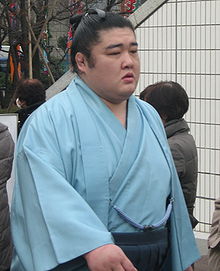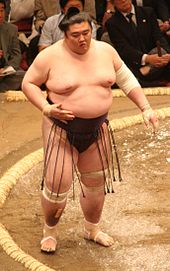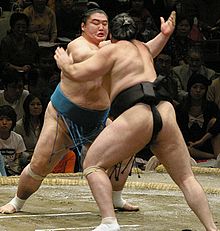- Dejima Takeharu
-
出島 武春
Dejima Takeharu
Personal information Born Dejima Takeharu
March 21, 1974
Ishikawa, JapanHeight 1.80 m (5 ft 11 in) Weight 160 kg (350 lb) Career Heya Musashigawa Record 595-495-98 Debut March, 1996 Highest rank Ōzeki (September, 1999) Retired July, 2009 Yūshō 1(Makuuchi)
1(Jūryō)
1(Makushita)Sanshō Outstanding Performance (3)
Fighting Spirit (4)
Technique (3)Kinboshi 6 (Akebono (2), Takanohana (2),
Wakanohana, Asashōryū)* Career information is correct as of July 2009. Dejima Takeharu (出島 武春, born March 21, 1974) is a former sumo wrestler from Kanazawa, Ishikawa, Japan. A former amateur champion, he made his professional debut in 1996, reaching the top makuuchi division the following year. In 1999 he won the yusho or tournament championship and earned promotion to the second highest rank of ōzeki, but he lost the rank in 2001 and, for the most part, remained a maegashira until his retirement in 2009. He won ten special prizes and six gold stars over his long career. He wrestled for Musashigawa stable.
Contents
Early career
Dejima did sumo at elementary school, where he was a rival of fellow top division wrestler Tochinonada.[1] He was an amateur champion at Chuo University. Dejima joined professional sumo in March 1996 at the age of 22, recruited by Musashigawa stable, home to then ōzeki Musashimaru. Due to his amateur success he was given makushita tsukedashi status and was allowed to make his debut in the third makushita division. He did not adopt a traditional shikona, and he only ever used his real name as an active wrestler. In January 1997 he captured the tournament championship in the second jūryō division and was promoted to the top makuuchi division. His rise was so rapid that his hair had not yet grown long enough to be fashioned into the traditional oichonmage topknot.
Dejima scored an impressive 11 wins in his top division debut, and was awarded two special prizes for Technique and Fighting Spirit. After another 11-4 score in September, in which he won two more prizes and earned his first two kinboshi or gold stars for defeating yokozuna, he made his sanyaku debut at sekiwake in November 1997. However, after winning five of his first six matches he injured himself on the seventh day and missed the next two tournaments. He made a full recovery and after reappearing in May 1998 he quickly returned to the sanyaku ranks at komusubi in September 1998, a rank he held for four straight tournaments.
Ōzeki
Dejima returned to sekiwake in May 1999 and produced a strong 11-4 record, and in the following basho in July 1999 he won his first top division yusho or tournament championship, defeating Yokozuna Akebono and Takanohana and both ōzeki to score 13-2 and then beating Akebono once again in a playoff. Dejima chose to henka the yokozuna in this bout, for which he received some criticism. Nevertheless, in addition to his yusho he was awarded all three special prizes on offer, for Technique, Outstanding Performance and Fighting Spirit. He was only the second wrestler after Takahanada to achieve this feat. After the tournament his promotion to ōzeki was confirmed. He was the fourth former amateur champion, after Yutakayama, Wajima and Asashio, to reach sumo's second highest rank. His stablemates Musōyama and Miyabiyama subsequently made ōzeki also, in March and May 2000 respectively. With Musashimaru at yokozuna, Dejima had three of his colleagues in the top two ranks, an advantage as sumo wrestlers never fight members of their own stables except in playoffs.
Dejima held onto his ōzeki rank for two years, with his best result being an 11-4 score in March 2000, but in July 2001 he was forced to pull out of the tournament with only three wins. As he had also made a losing score in May 2001, he was demoted from ōzeki. Returning in September, he needed ten wins to return to ōzeki but still in poor condition he could only manage a 5-10 record.
Later career
Subsequent injuries prevented Dejima from making any sustained attempt to regain ōzeki status, and aside from an 11-4 runner-up performance in January 2003 which briefly returned him to sanyaku, he largely remained in the maegashira ranks. He competed for 48 tournaments after dropping from the ozeki rank - longer than any other former ozeki in history until Miyabiyama overtook him.[2] Near the end of his career he was still capable of producing strong results, as he proved in January 2007 by defeating Yokozuna Asashōryū, the only wrestler to do so in that tournament.
In May 2007 he produced a strong 12-3 record, his second runner-up performance in makuuchi and his highest score in a tournament since his title win, and was awarded his fourth fighting spirit prize. In November 2007 he earned ten wins from the maegashira 2 rank, and won promotion to komusubi for the January 2008 tournament. His return to the sanyaku ranks after 27 tournaments away was the third slowest in the modern era. He was however able to win only three bouts there. In November 2008 he won his first six matches, but then lost nine in a row. In May 2009, ranked at maegashira 12, he seemed in danger of demotion from makuuchi after recording only three wins in the first nine days, but he made a partial recovery to score 7-8.
Retirement from sumo
In the July 2009 tournament, which came exactly ten years after his championship win, Dejima announced his retirement from active competition after suffering nine losses in the first eleven days, rather than face demotion to the second jūryō division.[3] He said he had no regrets and had done his best.
Dejima has stayed in the sumo world as a coach at Musashigawa stable under the elder name Onaruto Oyakata. His official retirement ceremony or danpatsu-shiki will be held at the Ryogoku Kokugikan on 29 May 2010.[4]
Fighting style
Dejima demonstrating his thrusting techniques against Kokkai
Dejima was an oshi-sumo specialist, favouring pushing and thrusting techniques (tsuki-oshi) over fighting on the mawashi or belt. His most common winning technique was oshi-dashi, or push-out, followed closely by yori-kiri or force out. These two techniques accounted for around 70 percent of his wins.[5] He rarely employed throwing moves, his most common being the beltless sukuinage or scoop throw which he used for only 3 percent of his victories.[5]
He was famed for his explosive start at the tachi-ai and so was often prone to being sidestepped at the initial charge. The technique which he has been defeated most often, aside from yori-kiri, is hataki-komi, a slap down move that is often the result of a sidestep.[5] He was also vulnerable to the pull down, hiki-otoshi.
He suffered from knee and ankle problems in recent years and had lost much of his speed and mobility. He remarked upon this at his retirement press conference, saying, "I have been battling with injuries and old wounds for some years now."[2]
Top division record
Dejima Takeharu[6]
year in sumo January
Hatsu basho, TokyoMarch
Haru basho, OsakaMay
Natsu basho, TokyoJuly
Nagoya basho, NagoyaSeptember
Aki basho, TokyoNovember
Kyūshū basho, Fukuoka1997 x East Maegashira #13
11–4
TFWest Maegashira #3
7–8
East Maegashira #4
8–7
East Maegashira #1
11–4
TO★★West Sekiwake
3–5–7
1998
Sat out due to injury
0–0–15
Sat out due to injury
0–0–15West Maegashira #11
10–5
FWest Maegashira #4
10–5
O★★West Komusubi
8–7
West Komusubi
9–6
1999 East Komusubi
8–7
West Komusubi
9–6
East Sekiwake
11–4
West Sekiwake
13–2–P
TOFEast Ōzeki
10–5
West Ōzeki
10–5
2000 East Ōzeki
9–6
East Ōzeki
11–4
East Ōzeki
8–7
East Ōzeki
10–5
West Ōzeki
10–5
East Ōzeki
9–6
2001 East Ōzeki
7–8
West Ōzeki
8–7
East Ōzeki
5–10
West Ōzeki
3–3–9
West Sekiwake
5–10
West Maegashira #3
7–8
2002 West Maegashira #4
6–9
East Maegashira #7
6–9
East Maegashira #9
9–6
East Maegashira #3
2–3–10
Sat out due to injury
0–0–15East Maegashira #10
10–5
2003 West Maegashira #3
11–4
★East Komusubi
8–7
West Sekiwake
7–8
Sat out due to injury
0–0–15East Maegashira #10
6–9
West Maegashira #14
11–4
2004 East Maegashira #6
10–5
East Maegashira #2
7–8
West Maegashira #3
7–8
West Maegashira #4
7–8
West Maegashira #5
10–5
East Maegashira #1
0–3–12
2005 East Maegashira #10
9–6
East Maegashira #5
7–8
East Maegashira #6
9–6
East Maegashira #2
7–8
East Maegashira #3
7–8
West Maegashira #3
5–10
2006 West Maegashira #6
8–7
West Maegashira #4
6–9
West Maegashira #7
8–7
West Maegashira #6
8–7
East Maegashira #3
7–8
West Maegashira #3
10–5
2007 West Maegashira #1
4–11
★East Maegashira #8
7–8
East Maegashira #10
12–3
FEast Maegashira #2
5–10
East Maegashira #4
8–7
West Maegashira #2
10–5
2008 West Komusubi
3–12
West Maegashira #6
6–9
East Maegashira #10
8–7
West Maegashira #8
6–9
West Maegashira #12
9–6
West Maegashira #5
6–9
2009 West Maegashira #7
7–8
East Maegashira #9
6–9
West Maegashira #12
7–8
West Maegashira #13
Retired
2–10–0x x Record given as win-loss-absent Top Division Champion Retired Lower Divisions
Sanshō key: F=Fighting spirit; O=Outstanding performance; T=Technique Also shown: ★=Kinboshi(s) P=Playoff(s)
Makuuchi ranks: Yokozuna — Ōzeki — Sekiwake — Komusubi — Maegashira
Divisions: Makuuchi — Jūryō — Makushita — Sandanme — Jonidan — JonokuchiSee also
- Glossary of sumo terms
- List of sumo tournament winners
- List of sumo tournament second division winners
- List of past sumo wrestlers
References
- ^ Sumo Fan Magazine
- ^ a b "Sumo: Former ozeki Dejima to hang up mawashi". Breibart.com. 22 July 2009. http://www.breitbart.com/article.php?id=D99JHUP02&show_article=1. Retrieved 3 Aug 2009.
- ^ "Sumo: Former ozeki Dejima to hang up mawash". Breibart.com. 22 July 2009. http://www.breitbart.com/article.php?id=D99JHUP02&show_article=1. Retrieved 2009-07-22.
- ^ "Coming Events". Japan Sumo Association. http://www.sumo.or.jp/eng/kyokai/event/index.html#01. Retrieved 10 November 2009.
- ^ a b c "Dejima bouts by kimarite". Sumo Reference. http://sumodb.sumogames.com/Rikishi_kim.aspx?r=31. Retrieved 4 June 2009.
- ^ "Rikishi in Juryo and Makunouchi". szumo.hu. http://www.szumo.hu/sekitori/Dejima.html. Retrieved 2007-06-04.
External links
- Sumo Association Biography (English) (Japanese)
- Official profile
- Complete biography and basho results (Japanese)
Categories:- 1974 births
- Living people
- Chuo University alumni
- Japanese sumo wrestlers
- Ōzeki
- People from Kanazawa, Ishikawa
- Sumo people from Ishikawa Prefecture
Wikimedia Foundation. 2010.


